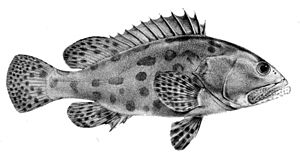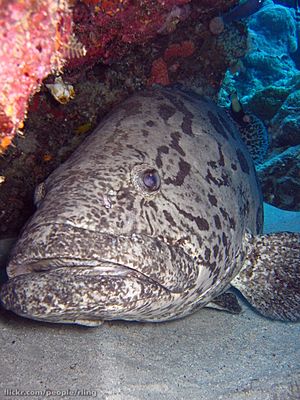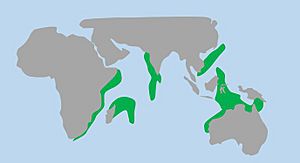Potato grouper facts for kids
Quick facts for kids Potato grouper |
|
|---|---|
 |
|
 |
|
| Conservation status | |
| Scientific classification | |
 |
|
| Potato grouper range (green) |
The potato grouper (Epinephelus tukula), also called the potato cod or potato bass, is a large fish that lives in the ocean. It's a type of grouper, which belongs to a bigger family of fish called Serranidae. This family also includes sea basses. You can find potato groupers in many parts of the Indo-Pacific region, which covers the Indian Ocean and parts of the Pacific Ocean.
Contents
What Does It Look Like?
The potato grouper is a very big and strong fish. It can grow up to 200 centimetres (79 in) long, which is about 6.5 feet! It can also weigh as much as 110 kilograms (240 lb), which is like a small person.
This fish has a pale brownish-grey color. Its body is covered in large, dark spots that are spread out. These spots often look like potatoes, which is how the fish got its common name. It also has dark lines that spread out from its eyes. You might see small dark spots on its fins too.
The potato grouper has two main fins on its back called dorsal fins. It has 11 stiff spines and 14 to 15 soft rays in these fins. It also has an anal fin with three spines and eight rays. Its tail fin is rounded.
Where Do They Live?
Potato groupers live in a wide area across the Indian and Pacific Oceans. However, they are not very common in most places. They are found most often along the eastern coast of Africa, from the Red Sea down to South Africa. You can also find them around islands in the Indian Ocean like Madagascar and Seychelles.
Further east, they live off the coast of India and Sri Lanka. In the Pacific Ocean, they reach as far as the Solomon Islands. They are found north to southern Japan and south to Australia. In Australia, they live along the northern coasts and on the famous Great Barrier Reef.
Habitat and Life
Potato groupers like to live in coral reefs. They are often found in channels within the reefs or around underwater mountains called seamounts. These areas usually have strong ocean currents.
Younger potato groupers, called juveniles, prefer shallower water. You might find them in tidal pools on the reef. Adult groupers live deeper, usually between 10 to 150 metres (33 to 492 ft) underwater.
These fish are usually solitary, meaning they live alone. They tend to stay within their own small home area. Potato groupers are ambush predators. This means they hide and wait for their prey to come close. They use the coral as cover. When a meal is nearby, they lunge out and swallow it whole!
They eat a variety of sea creatures, including:
- Small rays
- Crabs
- Other fish
- Squid
- Octopuses
- Spiny lobsters
Potato groupers can be aggressive and will defend their territory. They become old enough to reproduce at about 12 years of age. At this time, they are usually 90 to 99 centimetres (35 to 39 in) long and weigh around 16 to 18 kilograms (35 to 40 lb). Scientists have seen groups of smaller potato groupers together. It's possible they gather to lay eggs, but we don't know for sure yet. Like some other groupers, they might be able to change sex from female to male during their lives.
How Humans Interact With Them
People catch potato groupers for food in local fisheries throughout their range. They are also sometimes sold in the live fish markets in places like Hong Kong and China.
Even though they are caught for food, the IUCN says the potato grouper is a species of "Least Concern". This means they are not currently in danger of disappearing. They are even protected in countries like South Africa and Australia to help keep their populations healthy.
See also
 In Spanish: Mero patata para niños
In Spanish: Mero patata para niños


